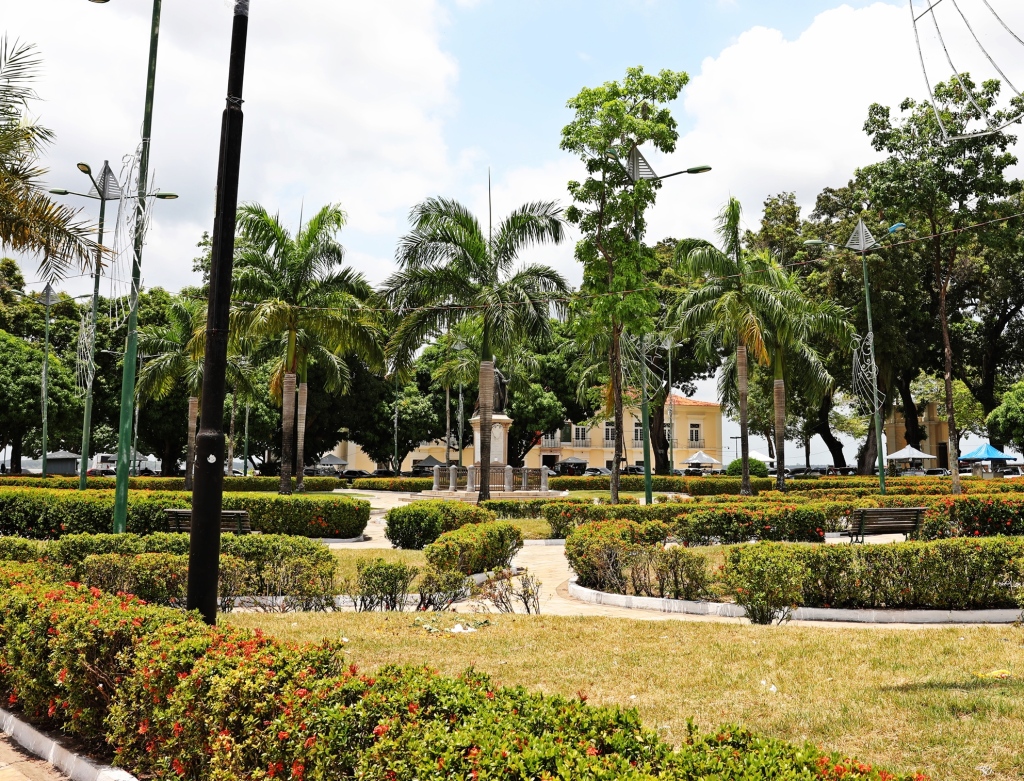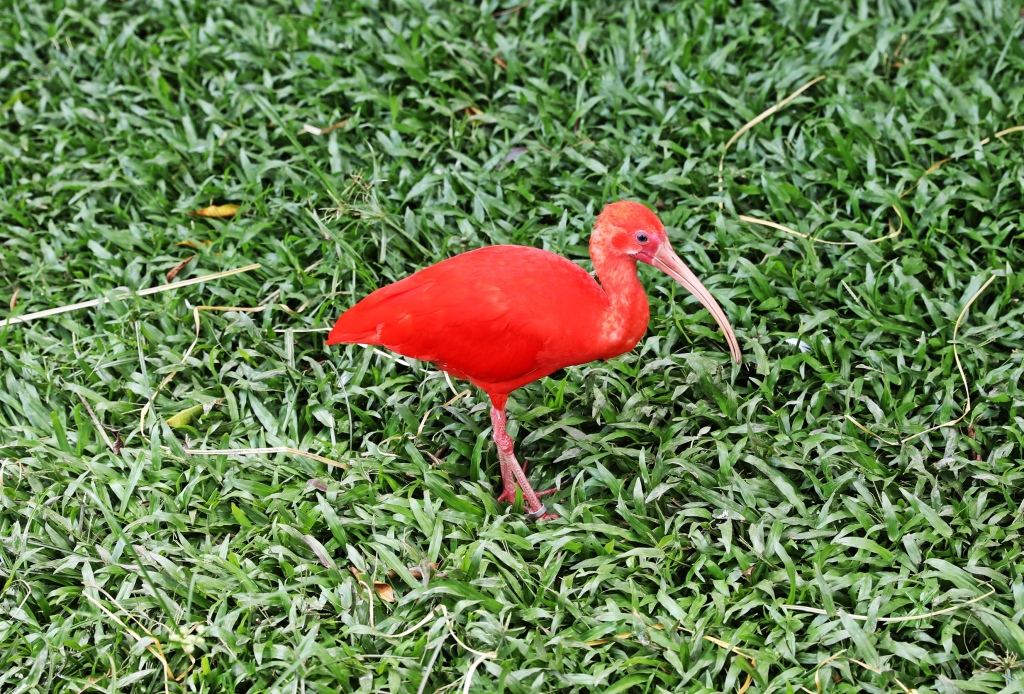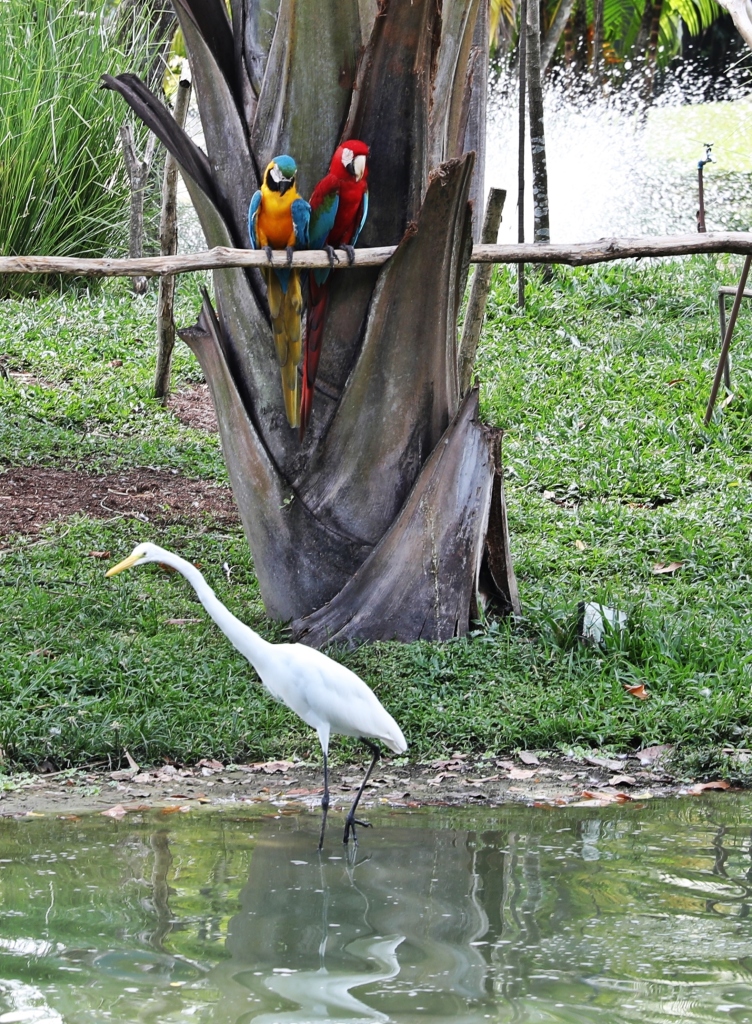It was night when our ferry approached the port city of Belém. Bright lights along the riverbank illuminated the towers of a church as well as historic buildings and a lively market. It made us excited to explore this city in the daylight.


Since its nickname is Cidade das Mangueiras which translates in English to City of Mango Trees, we expected to see a lot of mango trees in Belém. Nothing could have prepared us though for the shear number of mature mango trees there are in the city. Not only is every street lined by trees, in Belém they are lined by mango trees. Richard called them Belém’s weed.


Most of the trees were filled with mangos just waiting to ripen. On many, the fruit was growing in clusters like grapes, something we had never seen before. In places there were ripe mangos lying on the sidewalks. We saw locals collecting them, so we grabbed a couple for ourselves. They were juicy and delicious and became the first of many that we collected off the sidewalks in Brazil.

Belém is located on Pará River, not far from both the Atlantic Ocean and the Amazon River. This meant that it was a very important port city during Brazil’s rubber boom in the late 19th century. It became the financial centre of the rubber industry and made a lot of foreign merchants in Belém very wealthy. These affluent elites built many opulent buildings including mansions, stores, warehouses and a theatre. Materials were imported from Italy, France and England to decorate and furnish them in typical styles of the European elite.
Theatro da Paz (Peace Theatre)
Built roughly 20 years before the Teatro Amazonas in Manaus (read our story here), Theatro da Paz has a similar look. It’s not as ornate as the one in Manaus but does have a stately feel with its exterior peach stone walls and elegant white columns.

Inside it is as regal as it is from the outside. Most of the theatre is still in its original condition so it was easy to imagine how it looked in its heyday. A grand marble staircase leads you from the lobby up to the first floor. The walls are decorated with what looks like elaborate wallpaper, but is actually hand painted designs.

In the lobby we looked at the original seating chart which seems a bit disorganized. You would think that seats 1 and 2, 3 and 4 etc. are side by side, but they’re not. Even numbered seats are on one side of the aisle and odd on the other. It would make buying 2 or more seats beside each other a little more work than usual.

On the upper levels the wooden floors catch your eye. Acapu and yellowwood are set in a design meant to represent a Swastika, the Hindu symbol of peace to match the theatre’s name.

Inside the Auditorium, three tiers of balconies wrap around the stage. It was easy to imagine wealthy rubber barons watching a show from the original straw seats. A ballet was rehearsing in the auditorium so we sat down and pretended we were those barons for a few minutes.
The centre of the ceiling has a large mural that is said to depict the Greek God Apollo interacting with indigenous Amazonians. The interesting detail in this theatre compared to Manaus is that each private balcony has its own muraled ceiling.



Tours are held everyday except Monday and are only in Portuguese, but theater staff have written copies of the text in English. The tour lasts about 30 minutes and is free.
Praça da República (Republic Plaza)
The park around the theatre, is called Republic Plaza. It is of course, filled with mango trees loaded with fruit. Taking our attention away from the trees though were a couple of lovely colonial buildings used by theatre companies. At the entrance to the park is a large, ornate Greek styled gate and archways. The Greek theme seemed a bit out of place with the rest of the architecture, but matches the theatre’s ceiling I guess.



Forte do Castelo (Castle Fort)
When the Portuguese first arrived to this area in 1616 they established a fort and a settlement along the river and called it Feliz Lusitania. Today this small historical area is being revitalized. The first building the Portuguese established in Feliz Lusitânia was Castle Fort along the banks of the river. The fort was built to protect the new city from English and Dutch invaders. There’s not much left of the fort today but it still has original stone walls that you can walk on for a nice view of the river, the cathedral and the historical centre.
We thought there was an entry fee, but on the day we were there it was is free.



CATEDRAL NOSSA SENHORA DAS GRAÇAS (OUR Lady of Grace Cathedral)
The other main building in Complexo Feliz Lusitânia is Our Lady of Grace Cathedral. Built in 1755 the large church has a plain white exterior with typical Portuguese bell towers. Inside though it is a jaw dropping site with a long, high arched ceiling that is decorated with beautiful paintings. The alter is made of marble and alabaster and is elaborately sculpted. Both walls leading to the alter are sectioned into 10 individual stations each with a large painting. In the middle are two beautifully hand-carved wooden pulpits. It is a stunning building.
In sharp contrast, many of the other old buildings around the cathedral, including the one right beside it, are in ruins.




In front of the cathedral is the small Praça Frei Caetano Brandão (Friar Caetano Brandão Square) with the manicured hedges. Across from the park is another beautiful historic church. Igreja e Colégio de Santo Alexandre (Church and College of St. Alexander) is a former Jesuit complex, which operates today as a museum.



Historical Centre
Wandering around the historical centre we found many beautiful Portuguese-style buildings. One of the nicest is Palacio Antonio Lemos. Even though it is being renovated we could still see a lot of its beautiful details above the construction wall.

Most of the buildings in this part of the historical district date back to the rubber boom. By the early 1900s though, Brazil had become too expensive and too far away from Europe so alternative locations were sought out. The solution was to steal seedlings from Brazil and plant rubber tree farms in Malaysia. This quickly put an end to the economic boom in Belém and Manaus. After this downturn in the rubber market, many of the extravagant buildings suffered from neglect. Today they are a worn out shells of their former selves. It was a little sad to walk through the historic centre because for every renovated gorgeous old building there are many more in disrepair.



Mercado Ver-O-Peso (Check The Weight Market)
Markets in South America are often lively spots where you can feel the energy of a city. Brazil is no different. In Belém the main market is held in a shabby looking historical building along the river, not far from the port. We were warned by a few people ahead of time to be extra vigilant at the market because robberies are very common. As we were walking toward it, a local man saw Richard’s camera and made a point of telling us to keep the camera well hidden when inside or even on the streets around the market. Because of this we don’t have pictures of the market’s interior.
Our main reason for going to the market was to buy more Brazil nuts. The market is very large and it took us a while to find them. We passed through different sections that sold fish, meat, cheese, fruits, vegetables, crafts until finally we found the nuts. We bought 1 kilo of Brazil nuts or castanha-do-Pará as they’re called in Brazil, for R$30 ($5.70 USD), even cheaper than they were in Manaus!

Across from the market is a small port and clock tower. Porto Ver-O-Peso was filled with fishing boats that had just arrived back to port from their early morning catch. On the far side of the port are colourfully decorated old buildings. From a distance they looked wonderful, but as we got closer we saw they weren’t in very good condition.


Estação das Docas (Docks Station)
Only a couple of blocks away, but yet miles apart in comfort, the old docks have been converted to a new trendy restaurant row. Docks Station has a long boardwalk along Pará River. On the other side are dozens of patios from upscale pubs and restaurants. It was nice to be able to let our guard down and have a beer looking out onto the peaceful river.


Mangal das Garças (Mangrove of Herons)
Although we are not lovers of zoos, Mangal das Garças does it much differently. It is more like a combination botanical garden and bird sanctuary than a zoo and makes you feel as if you’ve left the city. The park is filled with large trees from the surrounding Amazon forest, native flowers and several types of local birds. Large ponds are fenced in to keep the birds safe, but the birds are free to go where they like. Wild birds often stop in for a few days and are welcomed by staff. It is a peaceful area where we could see many interesting birds up close.








Even though there were safety concerns and dilapidated buildings in downtown Belém, there are many areas that are very nice and we actually really enjoyed Belém. The part of town where we stayed was safe and it was very pleasant to walk along the mango tree-lined streets.

Safety in Brazil
We are usually careful when we travel but in some parts of Brazil, including Belém, we were extra diligent. We never travel with valuables such as jewelry and try to dress so we fit in as much as we can. Mobile phones are very popular to pick-pocketers and ours were always kept in zippered pockets or bags. We don’t carry large amounts of cash and only show small bills when shopping. Our most valuable item is the camera which is kept well hidden in a weathered camera bag and only brought out for short times when being used. In busy places such as markets there are more likely to be pickpockets so you need to be extra careful. In large cities, most tourist areas are safe during the day, but it is often not recommended to walk at night, especially alone.
How to get to Belém
Belem has an international airport and a large bus terminal. But many people, including us, arrive in Belem by Ferry. (read our story here)
To read about our other adventures in Brazil click here.
Coming Next – Colonial Buildings of São Luis
For pictures from other blogs go to Gallery at monkeystale.ca
To read about more of our adventures go to Destinations.
If you like what you read, please comment or share (with credit) using the links below.
112 comments